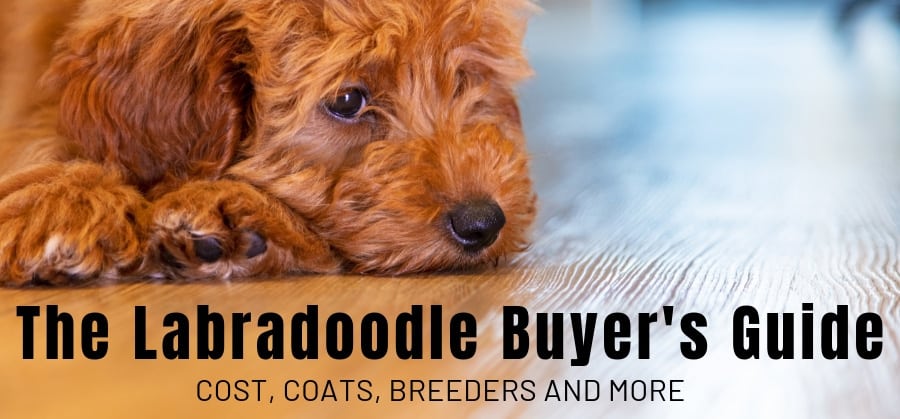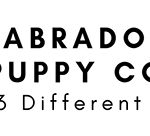
Whether you recently walked behind a fluffy Labradoodle butt on the way to the bus stop or your Facebook feed is currently filled with curly, smiling Doodle faces, your interest in the Labradoodle breed has obviously been piqued. If you’re considering adding one of these canine cuties to your family, you’re going to have a lot of questions, and this buying guide will have the answers.
Adopting any dog usually starts with a research foray. There are hundreds of questions that need answering. What prospective Labradoodle owners need to help them through the purchasing process from start to finish is a comprehensive Labradoodle Buyers Guide. This buyers guide covers the breed itself, including Labradoodle makeup, size categories, coat textures, temperament and breed characteristics. After learning about the breed, you’ll also need details about the process of actually buying: locating a high-quality breeder, preparing a list of important health questions to ask a breeder before buying and estimating total costs.
This guide checks all those boxes, which means you are that much closer to checking off the last box: Enjoy years of love and laughter with your new Labradoodle.
Overview of the Labradoodle Breed
The description of this breed is right there in the name: Labrador Retriever plus Poodle equals Labradoodle. That’s a pretty big generalization, as there is a lot that goes into your Labradoodle’s specific genetic makeup, and some Labradoodles may have more than just those two origin breeds in their family tree. Labradoodles can range in size, color, coat texture, behavior, personality, and overall health, and understanding the variations will help you choose a Labradoodle to fit your specific needs.
Overall, Labradoodles are friendly, sociable, and even-tempered. They are fairly easy to train, and their high sociability makes them a great fit for homes with other pets or children. This breed is well-known for its intelligence (probably from the Poodle parent), but it’s also famous for being outgoing and surprisingly calm, like a Labrador. There are lots to love in this breed’s temperament, which is why it’s so commonly found as a family pet.
How Big Will Your Labradoodle Get?
Labradoodles are cross-bred from Labrador Retrievers and Poodles, so their size is going to depend on the size of their Poodle forebear. Poodles range in size from the itty bitty Toy Poodle to the large and rather impressive Standard Poodle. The breeder you choose for your Labradoodle will have information on its heritage, so you can get a pretty good estimate of how big the curly guy will be when he is full-grown.
Labradoodles are separated into four basic categories based on size:
- Petite, also called a Micro LabraDoodle, about 8 to 15 pounds
- Miniature, about 15 to 25 pounds
- Medium, about 25 to 45 pounds
- Standard, about 45 to 75 pounds
While there’s no way to guarantee the final adult size of your Labradoodle, your pup’s pedigree chart will give a pretty good indication. If you’re looking for a smaller Doodle to fit your lifestyle, be sure to ask your breeder if they have litters with a Toy Poodle parent. If you’re strictly in the market for a giant, dopey ball of fluff, you’ll want a litter with a Standard Poodle parent in the mix. You can read more about Labradoodle sizes and the importance of good breeding here.
The Labradoodle Coat
The size and temperament of the Labradoodle are all well and good, but let’s take a moment to discuss the Labradoodle characteristic that we’re all really here for: that luscious, cloud-like coat of curls! This is far and away what most attracts potential owners to the breed from the get-go. Labradoodles are known for their gorgeous, curly coats that come in a variety of textures and colors.
There are three coat textures found in Labradoodles:
- Straight Coats
- Wool Coats
- Fleece Coats
Straight Labradoodle coats feature more of the Labrador Retriever texture and appearance. At first glance, these pups might not even look like Labradoodles, though there can be some slight curling in the hair, especially when it’s wet. Straight coats are easy to maintain (they only require a bit of regular brushing), but they may be more prone to shedding.
Wool coats are the opposite: they feature more of the Poodle heritage. Wool coats are extremely curly, and they may also be slightly rougher in texture. These coats require regular grooming to prevent matting, but they are the least likely to shed or produce excessive dander.
Fleece coats, then, are the perfect in-between, featuring the softness of the Labrador Retriever fur with the attractive curliness of the Poodle’s coat. Labradoodles with the coveted Fleece coat are generally more expensive than their straighter- or rougher-coated cousins, and they require expert grooming and care to keep the fur looking beautiful. For more information about a Labradoodle’s specific grooming needs based on its fur type, check out this article.
Australian vs. American Labradoodles
Depending on where you are in your Labradoodle research, you may have stumbled across the often confusing Australian Labradoodle breed. What’s the difference? An American Labradoodle is strictly a cross-breed between a Labrador Retriever and a Poodle. That’s where the breed gets its name, and the American version keeps it pretty simple.
An Australian Labradoodle is a horse of a different color. In an attempt to perfect the hypoallergenic nature of many Doodles’ coats, some different dog breeds were introduced into the mix in the Australian version. Since the Labradoodle is not an official breed regulated by kennel clubs throughout the world, variations can and do occur. In Australia, the Labrador Retriever was bred with a mix of Poodle and Irish Water Spaniel or Curly Coated Retriever. The inclusion of these other breeds in a pup’s pedigree may indicate that her coat is less likely to shed or produce excessive dander.
Breed Designations
The Labradoodle breeder you select may designate his puppies with various codes that correspond to the parentage of that particular dog. You might also hear phrases such as “multigenerational” or “first cross generation” when discussing available Labradoodle litters. These codes and terms are very in-world, and they can be difficult to decipher if you are just stepping into the world of reputable dog breeders.
If you’re searching for detailed information about breeding terminology, you can read a more in-depth article about Labradoodle breed types and their associated pros and cons here. For those just getting their feet wet, here’s a quick rundown of what you need to know about breed designations.
- F1: 1 Purebred Labrador Parent and 1 Purebred Poodle Parent
- F1b: 1 Purebred Parent and 1 F1 Labradoodle Parent
- F2: Both Parents are F1 Labradoodles
- F2b: 1 F1 Labradoodle Parent and 1 F1b Labradoodle Parent
- F3: Both Parents are F2 Labradoodles
- F3b: 1 F2 Labradoodle Parent and 1 F2b Labradoodle Parent
- Multigenerational: Both Parents are F3 Labradoodles
Generally speaking, multigenerational Labradoodles are the most coveted types of the breed simply because their genetic characteristics have been carefully selected through a long line of Labradoodle generations. Here is where you’ll see the most consistency in a single litter, so characteristics such as temperament, coat type, health prognosis, and allergy/shedding issues are easy to predict. It’s also where you’ll generally see the highest price for a Labradoodle puppy. Breeders can increase the price because they can tell a prospective owner exactly what to expect with a particular puppy.
Conversely, an F1 litter will see more genetic variation amongst pups in a single litter. If a Labrador and a Poodle mate, each of their offspring will display Labrador and Poodle characteristics in different ways, so you may get a wide variety of coat colors and lengths, some puppies may exhibit more Poodle-like behavior, and other puppies may have more Labradoodle-like qualities. This isn’t to say F1 generation puppies are problematic; each puppy may grow up to have a superb combination of Labrador and Poodle behavior and appearance traits. It’s simply more difficult to predict.
How Much Will My Labradoodle Cost?
Most prospective buyers want to know one simple thing before jumping into the world of Labradoodle ownership: how much is this going to cost? Unfortunately, it’s impossible to give such a simple question an equally simple answer because the factors that determine the cost of a puppy are so numerous.
Cost factors may include:
- Multigenerational vs. First Cross breed
- Genetic Quality and Parental Characteristics
- Experience and Popularity of the Breeder
- Neonatal and Postnatal Care Costs
- Regional Cost Variations
- Popularity of the Labradoodle Breed In Your Area
You should expect to pay between $1200 and $3000 for your new Labradoodle puppy, and you can read more about the variation in Labradoodle puppy costs here. If this price sounds insane to you (you’re not alone), consider everything that goes into successfully breeding a healthy, curly, little bundle of joy.
First, breeders must keep careful records of the adult dogs used in a breeding program. They have to monitor adults’ temperaments, physical characteristics, and health problems, so they know what they are mixing into a new litter. Breeders need basic knowledge of how different genes are expressed in a Labradoodle family tree, so they can be sure not to breed a litter of puppies prone to aggression or at risk for health issues like hip dysplasia.
Breeders are also responsible for tons of care in the first few weeks of a puppy’s life. Puppies need to be cleaned constantly, handled regularly for socialization, and monitored for health defects in the early stages. Typically, puppies receive a complex regimen of vaccinations and immunizations at various stages of development, and the breeder is responsible for all of these upfront costs. Most of that $3000 is just a breeder recouping the time and money she’s already invested into your puppy.
Also, some breeders offer their assistance even after you take a puppy home. They may provide you with a carefully crafted how-to guide for raising your new Labradoodle, and many make themselves available to answer questions, provide breed insights, and make recommendations for veterinary or grooming services when your puppy needs them. The upfront cost you pay for your Labradoodle puppy is an investment in that puppy’s future. It may seem expensive, but you are paying for your dog to have the best chance at a happy, healthy life.
How To Choose the Right Breeder
A Labradoodle breeder is potentially the single most important person in your new puppy’s life. Breeders’ behaviors make the difference between healthy puppies with a promising life ahead of them and sickly puppies with a myriad of potential health issues, socialization problems, and years of uphill climbing ahead of them.
How, then, do you choose a breeder that will set your pup up for success rather than failure? The key is in the questions. Do not be afraid to pepper a breeder with questions about their breeding process, their credentials, and their care techniques. A good breeder will answer these questions directly and openly.
Here are some potential breeder questions to get started:
- How long has your breeder been in the business?
- What records does your breeder keep on a litter’s parents?
- What is the state of the facilities? Are the animals clean and safe?
- What medical treatments do puppies and breeding mothers receive?
- Is your breeder recommended by local veterinarians?
- What are customers saying about your breeder on social media?
- When will you be permitted to visit the newborn puppy?
- Will your breeder be available to answer questions after adoption?
This isn’t a comprehensive list of breeder questions, and you may have other questions or concerns when communicating with a potential breeder. However, this list is a great starting point. It shows the breeder that you are conscientious and curious, and the answers to these questions will quickly show you if a prospective breeder can be trusted.
My Experience Working With A Breeder
Health Questions To Ask Your Labradoodle Breeder
Asking health questions of your Labradoodle breeder is crucial to seeing that you go home with a healthy, lively puppy who isn’t going to unexpectedly get sick or have developmental issues as she grows up. Plain and simple: breeders are responsible for generating healthy litters of puppies. To ensure that you are adopting a healthy dog, ask lots of questions of your Labradoodle breeder about genetic history, pedigree, vaccination schedules, and care details.
Here are some suggested questions that potential Labradoodle adopters should ask of their breeders:
- What is the health history of both parents?
- Will you get to meet the parents of your Labradoodle puppy?
- What experience does the breeder have with the health risks associated with the Labradoodle breed?
- What vaccinations or immunizations are given to puppies?
- What is the weaning process for Labradoodle puppies?
- How and when are puppies socialized? Are they taught to interact with people? Are they exposed to new environments?
- At what age are puppies weaned?
- What does the breeder do if an adopted puppy is found to be unhealthy?
A list like this might sound like you’re prepping for a criminal interrogation, but a good breeder won’t balk at questions like these. High-quality breeders are trying to pair healthy puppies with excellent owners, so they’ll likely have just as many questions for you as you have for them.
Breeder Selected, What’s Next?
Alright, you’ve picked the breeder who is going to pair you with your Labradoodle puppy. While it’s tempting to say “the hard part is over,” if you know anything about raising dogs then you know that this isn’t quite the case. Choosing your breeder is a perfect first step, but there are plenty more steps to come even before you bring your puppy home. Once your breeder is selected, here’s what you can expect throughout the rest of the process.
The Perfect Age for Adoption
One of the most common questions that breeders receive from prospective puppy parents is “How soon can I pick my puppy up?” They get it; you’re excited and incredibly eager to have your snuggle buddy home. However, the age at which a puppy is permanently separated from its mother is crucial, and sometimes waiting a few weeks is the best option for your new Labradoodle.
Eight weeks is the golden age for adopting a puppy. The dog is old enough to be weaned onto puppy food and off his mother’s teat, but he is still young enough to be taught proper socialization behaviors. Adopting a puppy younger than seven weeks may lead to social problems like separation anxiety or health issues due to early weaning. Puppies adopted when they are older than twelve weeks may require a little extra training to correct socialization issues and eliminate undesirable behaviors.
When you select a reputable breeder, you are choosing a person with years of experience breeding Labradoodles and separating the puppies from their mother. They’ll have insider information about the breed and the litter, and they’ll be able to make a recommendation for appropriate adoption age. Trust your breeder as they have your puppy’s best interests at heart.
The Labradoodle Adoption Process
The adoption process itself can be time-consuming and a little stressful, so it’s helpful to know what to expect from start to finish. First, you should expect to pay a deposit for your Labradoodle. This deposit is essentially a cash promise that you are interested in adopting a puppy. The breeder may use this deposit to cover the cost of vaccinations and early care, and it essentially holds the puppy in your name until she is old enough to be separated from her mother. Deposits usually range between $250 and $500 for a Labradoodle.
Some breeders start getting deposits for Labradoodle puppies before the litter is even born, so you may be paying money sight unseen, but this shouldn’t concern you if the breeder is reputable because the puppy’s health, behavior, and even its physical characteristics are all but guaranteed by its genetic history. If you paid a deposit before the puppy was born, the breeder might require an additional deposit after birth to cover medical and other care expenses. These deposits will be subtracted from the total cost of the puppy, so you aren’t necessarily paying more for the dog. Think of it as a payment installment program: you pay a little bit at various stages until your dog is ready to be adopted.
You may be required to submit paperwork for the adoption process, and a breeder may be interested in your family makeup, your living situation, your experience with dog ownership, and your plans for caring for or training your new family member. If this Labradoodle puppy is the first dog you’ve ever owned, don’t worry. You are not automatically excluded from dog ownership just because you’re new to the club. Most breeders just want to make sure the dog will be loved and well-treated. Answer questions honestly and completely, and if you have questions about raising a Labradoodle, be sure to ask the breeder. They’ll love knowing that you are interested and determined to raise the puppy right.
Training and Socializing Your New Puppy
Once Fido is home and acclimated, you’ll need to start thinking about training and socializing. NY Times bestselling author Nora Roberts once said “Everything I know I learned from dogs,” but the flip side of that statement is more often true. Everything your dog knows he or she learned from you.
Training your Labradoodle puppy helps him to learn the nature of his relationship with you, and it helps him understand how he fits into your family. Training can identify and eliminate problem behaviors before they become, well, problematic. Issues like digging, jumping, barking, or chasing can all be corrected with patient, consistent training.
Socialization is also a crucial part of the puppy-rearing process. Properly socialized Labradoodle puppies are good with people, kids, and other dogs. Most socialization just happens naturally through exposure. Be sure to introduce your puppy to people and dogs of all sizes and ages as early as possible, so your dog can learn the polite ways to behave with others. Remember to give your puppy time to acclimate to a new social situation, and make sure there is a space for your Labradoodle to retreat if she starts to feel overwhelmed.
What If You Can’t Care For the Labradoodle Puppy?
It’s an uncomfortable subject, but one that is worth discussing. What happens if, despite all your research and preparation, you get your Labradoodle puppy home and realize that it’s just not going to work out? These things happen. Your work or social life may get in the way of properly caring for your puppy. You might discover that your child is scared of the puppy or that your Labradoodle doesn’t socialize well with children. An unexpected life change, like a move, may make dog ownership more difficult.
Whatever the reason, it’s important not to feel like a failure if Labradoodle ownership becomes more difficult than expected. The key is to ensure that your puppy finds a good home where it will receive the care and love it deserves. Sometimes, breeders have a clause in adoption contracts where they get “first dibs” if you decide to give up your Labradoodle puppy. Breeders have a huge network in the dog world, and they may be better suited to home your puppy if you decide not to keep it.
Related Questions
Are Labradoodles Hard to Train?
Labradoodles are not a difficult breed to train, but they are a breed that requires patient and consistent training. The happy-go-lucky Labrador Retriever in your Doodle means that he is going to always be eager to please, but this child-like characteristic of the breed means that Labradoodles can be rambunctious and mischievous if they don’t receive expert training during puppyhood. A 12-week course of puppy training is a perfect solution for you and your new friend.
Are Labradoodles Good With Kids?
There are always going to be variations in personality when discussing a breed as a whole, but generally, Labradoodles are excellent dogs for households with kids. Labradoodles are patient and fairly even-tempered, so they aren’t prone to outbursts of emotion or violence. These animals also tend to be on the larger side (especially if one parent is a Standard Poodle), which makes children less intimidating to the dog. Expose puppies to gentle play with children as early as possible, so they learn appropriate social behaviors.
How Active Are Labradoodles?
Labradoodles are an active and energetic breed, and they need regular exercise to be healthy and happy. A Labradoodle that doesn’t receive adequate exercise may exhibit behavioral issues caused by stress and anxiety. Your Labradoodle doesn’t need to complete a marathon each week, but 30 minutes of walking a day will make a huge difference.
Go Forth And Get Thy Doodle
Finding a new puppy for your family can be incredibly overwhelming. There are thousands of dog breeds available, pros and cons to each breed, vast numbers of available breeders, and many factors to consider in picking the perfect dog. A Labradoodle is a great choice for a family pet, but even within this one breed, there are multiple factors to consider.
You are way ahead of the game simply because you are already researching this fantastic breed. Learning about its development, appearance, behavior, breeding, and trainability will all help you be better prepared when you bring this squirming bottle of liquid sunshine into your home. You’re never going to know everything about your future Labradoodle, and that’s ok. With this buying guide, you’ve got enough information to get started. Go forth and get thy Doodle, and remember: keep learning and keep loving, and you’ll both be happy.

![[Buyer's Guide] Dog Detangler Sprays That Actually Work! (2024) A Cavalier King Charles Spaniel lying on a woman's lap while being brushed.](https://www.trendingbreeds.com/wp-content/uploads/2020/11/Cavalier-King-Charles-Spaniel-and-brush-150x150.jpg)


